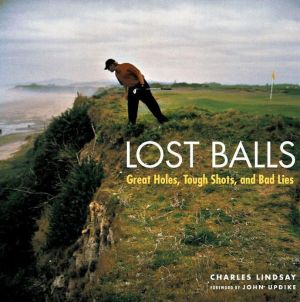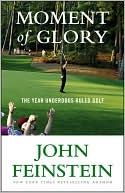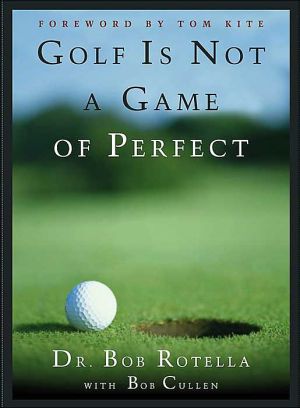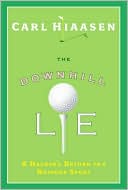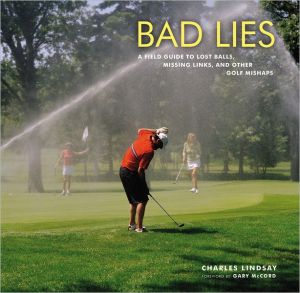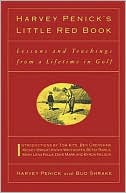The Greatest Game Ever Played: Harry Vardon, Francis Ouimet, and the Birth of Modern Golf
The book that hits the sweet spot is now a major motion picture! Announcing the official movie tie-in edition of Mark Frost+s award-winning The Greatest Game Ever PlayedThe riveting tale of one of golf+s most defining moments comes to life on-screen this fall from Walt Disney Pictures+and is sure to spark renewed interest in Mark Frost+s sensational book of the same name.The movie The Greatest Game Ever Played is directed by Bill Paxton and stars Shia LaBeouf (I, Robot), Stephen Dillane (King...
Search in google:
The book that hits the sweet spot is now a major motion picture! Announcing the official movie tie-in edition of Mark Frost's award-winning The Greatest Game Ever Played.The riveting tale of one of golf's most defining moments comes to life onscreen this fall from Walt Disney Pictures . . . and is sure to spark renewed interest in Mark Frost's sensational book of the same name. The movie The Greatest Game Ever Played is directed by Bill Paxton and stars Shia LaBeouf (I, Robot), Stephen Dillane (King Arthur, The Hours), Peter Firth (Pearl Harbor), Elias Koteas, and Peyton List. It will be released in September '05 from Walt Disney Pictures. Mark Frost is the author of the award-winning The Greatest Game Ever Played and the bestselling The List of 7, The 6 Messiahs, and Before I Wake. He received a Writers Guild Award and an Emmy nomination for his work as executive story editor on the acclaimed television series Hill Street Blues, and was the co-creator and executive producer of the ABC television series Twin Peaks. An avid golfer, he lives in Los Angeles and upstate New York. New York Times Book Review Tells this story at the perfect pace.
Harry Vardon and Francis Ouimet came from different worlds and different generations, but their passion for golf set them on parallel paths that would collide in the most spectacular match their sport has ever known. Through hard work, courage, and determination, Vardon had escaped a hopeless life of poverty in Britain to achieve universal recognition as the greatest champion in the game's long and storied history. Ouimet, a virtual unknown from Massachusetts, was only three years removed from his youthful career as a lowly caddie. He worshiped Vardon, a man twice his age, innovator of the modern grip and swing, daring only to dream of following in his herds footsteps.\ When these two unlikely opponents finally came together in their legendary battle at the 1913 U.S. Open, the world's reaction to its remarkable drama and heartstopping climax gave rise to the sport of golf as we know it today.\ Weaving together the stories of Vardon and Ouimet to create his narrative, Mark Frost has crafted a uniquely involving, intimate epic; equal parts sports biography, sweeping social history, and emotional human drama.\ Author\ Mark Frost is the author of the bestselling novels The List of 7, The 6 Messiahs, and Before I wake. This is his first nonfiction book. He received a Writer's Guild Award and an Emmy nomination for his work as executive story editor on the acclaimed television series Hill Street Blues, and was the co-creator and executive producer of the ABC television series Twin Peaks. He lives in Los Angeles and upstate New York.\ Reviews\ "Anyone who loves golf, history, or just a great story will relish this wonderful book"\ --Scott Turow\ "Put on a pair of soft slippers and get into your favorite chair. You are about to drift back to the era of gutties and wooden shafts. Mark Frost made me sit down and stay put as golf history comes to conversational life in this very entertaining book."\ --Gary McCord, author and CBS golf analyst\ "Francis Ouimet's showdown with Harry Vardon was a watershed moment that changed the face of golf. At least this remarkable story has been give the epic treatment it so richly deserves."\ --Butch Harmon, Tiger Woods' coach\ "This is one of the best sports books I have ever read. If I had known there was this much excitement in golf I would have started playing earlier."\ --Billy Crystal\ "The story of the 1913 U.S. Open at Brookline needed to be told again, especially today, and Mark Frost has done a wonderful job of capturing the moment of golf's awakening in America. His work is thoroughly researched and he has brought out the characters splendidly -- as well as the excitement of young Francis Ouimet's victory."\ --Ben Crenshaw, 1999 U.S. Ryder Cup captain\ "I am a traditionalist and if you are a traditionalist, you will enjoy this book. It will give you great insight into how golf got its start in America, and the man who really introduced golf to America: Francis Ouimet."\ --Ken Venturi, former CBS golf senior analyst and 1964 U.S. Open champion\ Excerpt\ The following is an excerpt from the book The Greatest Game Ever Played: Harry Vardon, Francis Ouimet, and the Birth of Modern Golf\ by Mark Frost\ Published by Hyperion; October 2002; $30.00US/$42.00CAN; 0-7868-6920-8\ Copyright © 2002 Good Comma Ink Inc.\ FRANCIS\ It begins with the simplicity of a fairy tale.\ A small boy, combing through fields of grass for buried treasure, uncovers a magical talisman: a gleaming white ball, pristine, perfectly round, untouched by wear. Two words emblazoned on its cover: VARDON FLYER. That name, so suggestive of powerful, confident, dreamlike flight, burns itself into the boy's impressionable psyche. After seven- year-old Francis Ouimet races home to place the ball in the dented tin box that guards his growing cache of riches, the VARDON FLYER immediately becomes his most prized possession. A gift from an unknown god named Vardon. \ \ Geography may be destiny, but in the case of Francis Ouimet, destiny may have been more a result of real estate. The day before Harry Vardon's twenty-third birthday in 1893 -- the year he entered his first British Open Championship -- Francis DeSales Ouimet was born in Brookline, Massachusetts, a sleepy Boston suburb. Four years later, his family purchased a modest little two-story clapboard house directly across from The Country Club, on a dusty dirt road called Clyde Street. \ Francis's father, Arthur Ouimet, a French-Canadian Catholic immigrant, depended on odd jobs to make ends meet; occasionally he'd find them as a coachman or gardener for The Country Club's affluent members. After six generations in Quebec, Arthur was the first of his family to leave Montreal, fleeing the oppressive thumb of the English-Protestant majority to seek his fortune in America; what he found instead was heart- break. Uneducated, his English clotted with a thick Quebecois accent, the best Arthur could manage in Massachusetts was a life of menial labor governed by the subtle but still profound prejudices of the nineteenth-century Boston gentry. Bostonians called this wave of immigrants "Frenchies," consigning them to servile positions that the city's second-generation Irish no longer considered suitable to their rising station.\ After establishing himself on Brookline's lower margins, at the age of twenty-eight Arthur Ouimet fell in love and married a beautiful Irish girl named Mary Mahoney. Three years later Mary died in childbirth and their sickly child, named Joseph after Arthur's father, followed her in death only ten weeks later. The disaster scarred Arthur for life; from that point forward he was described only as a cold, hardworking man with a hot and ready temper. He married again in 1888, to another Irish lass, twenty- seven-year-old Brookline native Mary Ellen Burke. Although she was a warm, loving, and infinitely patient woman, for Arthur this second marriage exuded less romance than an air of nineteenth-century practicality, creating a family in order to solidify his economic standing. Within eight years Mary gave him four children: Wilfred, the oldest by three years, then Francis, a daughter, Louise, and finally Raymond, the youngest, born in the house on Clyde Street that Arthur had bought that year. Haunted by nightmarish visions of sliding back down into abject poverty, Arthur had nevertheless put enough aside to buy some of the vacant land behind the house as well. They raised chickens, grew vegetables, sank their own well. Arthur drummed into his children the hard necessity of contributing to the family's welfare; his oldest son, Wilfred, began to caddy at The Country Club not long after the Ouimets moved into their new home. \ The house on Clyde Street sat directly across from The Country Club's seventeenth fairway and green, the sight Francis woke to every morning outside his second-floor bedroom window. Soon after they moved in, his mother used to routinely find Francis, at the age of four, standing across the street, staring at players on the fairway through a stand of beech trees. He didn't know how, he could never later even adequately explain why, but from his first glance, Francis found the forms and rituals of the game mesmerizing. Golf seeped into his young mind; it may be no exaggeration to say Francis was America's first golf addict who grew up with the game. His family's earliest recollection of the boy would be right at home in a nineteenth-century tall tale, befitting the kind of legends told about Mike Fink or Paul Bunyan; he walked around the house crying for his brother Wilfred's first golf club. When he finally got his hands on it -- a cut-down driver, nearly as tall as he was -- Francis spent countless hours swinging that club in their backyard. He began attending the one-room Putterham Schoolhouse the following year, and discovered a trespassing shortcut that traversed The Country Club's fairways. Francis soon developed an uncanny eye for locating lost golf balls on his daily commute and by the age of seven had amassed that precious trove he kept in the old gingersnap tin under his bed. \ Francis and Wilfred began their playing careers on the seldom traveled dirt surface of Clyde Street in front of the Ouimet home, digging out holes with the heels of their boots at the base of two streetlamps a hundred yards apart, knocking balls endlessly back and forth. Before they made much headway as players, they turned themselves into golf course architects. When their father brought home a new lawn mower to use on his gardening jobs, the boys waited until Arthur was away at work, then appropriated the mower to hack a primitive three-hole course out of the overgrown cow pasture behind their house. \ The first hole required a hundred-yard carry off the tee over a creek to a small oval green. The second provided a breather, a fifty-yard par three. The third returned back across the creek to a circular green they stamped into their own backyard. Before long that home green required no mowing at all; they trampled it so often, they wore out the grass. Tin cans from the family kitchen served as cups. Their equipment consisted of Wilfred's one club and Francis's hoard of lost balls. He was fortunate The Country Club continually replenished his supply because their training ground demanded unerring accuracy; it consisted more of hazard than fairway -- marsh, gravel pit, swamp, high weeds. Hitting any ball more than a few yards off line into the unknown wilderness meant kissing it good-bye. Francis said later that as a result of learning the game on this primitive lay- out, every real course he subsequently played, no matter how ragged the fairways or threadbare the putting surfaces, felt as luxurious to him as White House lawns and green felt billiard tables. \ Francis found little companionship at first for his mysterious attraction to the game; American golf was only five years older than he was, making him both prodigy and pioneer. The same could be said for the club across the street that sparked and nurtured his obsession; only a handful of courses in the United States predate The Country Club and few that came into existence afterward ever took to the game with equal alacrity. Because they opened their doors in 1882, The Country Club at Brookline makes an airtight argument for itself as sui generis; they were a club and it was in the country, hence its members became the first American organization to use the now generically applied name for private sporting establishments. But they didn't start out playing golf. Although The Country Club immediately attracted a solid, prosperous membership of Boston Brahmins, the Scottish game was still six years away from setting down roots in New England soil; horse racing and riding at hounds were The Country Club's original organizing interests. The hundred acres they acquired for that purpose centered around a half-mile racetrack called Clyde Park that had been in continuous operation since the 1860s. The legal structure of The Country Club allowed its members to assume financial responsibility for an annual racing season that filled the track's grandstand with spectators from miles around at fifty cents a head; with that income underwriting their ambitions, facilities for target shooting, archery, tennis, polo, ice-skating, and curling soon followed. A simple two-story roadhouse and former hotel on a bluff overlooking the heart of the property became their clubhouse, and over the years expanded in all directions into the genteel, rambling, pale yellow mansion that still plays host to its members today. \ In March of 1893, two months before the birth of that boy who'd soon be scavenging her fairways, in response to increasing member curiosity The Country Club added a rudimentary six-hole golf course that leapfrogged back and forth around the racetrack. Built in its entirety for the modest sum of fifty dollars spent on a few bags of grass seed, sand for primitive bunkers, and nine tin cans for holes. When early enthusiasts conducted their first exhibition of the game that spring, golf at The Country Club made an astonishing debut, hinting at the magic to come. The first shot struck off the first tee by a Mr. Arthur Hunnewell ran like a scared rabbit ninety yards to the green and dove neatly into the cup for a hole in one. Since no one knew any better, the small crowd who had turned out to watch the proceedings didn't even react; since they'd been given to understand that putting the ball in the hole was the whole point of the exercise, they just assumed this was business as usual. Arthur Hunnewell played golf passionately for another thirty years. He never scored another ace in his life. \ Copyright © 2002 Good Comma Ink Inc.
\ From Barnes & NobleIn 1913, British golfer Harry Vardon, the Tiger Woods of his day, encountered an unexpected roadblock to winning the 1913 U.S. Open: an unknown 20-year-old American amateur named Francis Ouimet. Nobody was more surprised than Ouimet himself: The former caddie from the wrong side of the tracks had entered the match mainly to catch a few glimpses of Vardon, his hero. Instead, the young Massachusetts golfer matched Vardon and his British colleague Ted Ray stroke by stroke, round by round. At the end of 72 holes, the three golfers were tied, necessitating a playoff. Award-winning writer Mark Frost tells the story of "the greatest game ever played" as it's never been told before.\ \ \ \ \ Seattle Post-IntelligencerA dramatic tale of sportsmanship, grace and history with a conclusion worthy of a thriller.\ \ \ Boston GlobeJumps off the page and demands to be read.\ \ \ \ \ New York Times Book ReviewTells this story at the perfect pace.\ \ \ \ \ Scott TurowAnyone who loves gold, history, or just a great story will relish this wonderful book.\ \ \ \ \ Gary McCordPut on a pair of soft slippers and get into your favorite chair. You are about to drift back to the era of gutties and wooden shafts. Mark Frost made me sit down and stay put as golf history comes to conversational life in this very entertaining book.\ \ \ \ \ Butch HarmonFrancis Ouimet's showdown with Harry Vardon was a watershed moment that changed the face of golf. At least this remarkable story has been give the epic treatment it so richly deserves.\ \ \ \ \ Billy CrystalThis is one of the best sports books I have ever read. If I had known there was this much excitement in golf I would have started playing earlier.\ \ \ \ \ Ben CrenshawThe story of the 1913 U.S. Open at Brookline needed to be told again, especially today, and Mark Frost has done a wonderful job of capturing the moment of golf's awakening in America. His work is thoroughly researched and he has brought out the characters splendidly — as well as the excitement of young Francis Ouimet's victory.\ \ \ \ \ Ken VenturiI am a traditionalist and if you are a traditionalist, you will enjoy this book. It will give you great insight into how golf got its start in America, and the man who really introduced golf to America: Francis Ouimet.\ \ \ \ \ Scottish Golf MagazineScottish Golf's book of the year. . . A great story.\ \ \ \ \ San Diego Union-TribuneAn absolute must-read for anybody who loves history and golf.\ \ \ \ \ Los Angeles TimesCompelling . . . a fascinating story.\ \ \ \ \ Publishers WeeklyThis first nonfiction effort by Frost, who is a novelist (The List of Seven), television producer (Twin Peaks) and scriptwriter (Hill Street Blues), deftly tells the story behind the legendary 1913 U.S. Open, in which Francis Ouimet, a 20-year-old golf amateur from Massachusetts, shocked the genteel golf world by defeating British champion Harry Vardon, the most famous pro golfer of his time and the inventor of what today is still considered the modern grip and swing. Frost knows he has a good story and manages to touch on all the right elements of the plot: Ouimet and Vardon not only represent two different social worlds and two different generations, but also share a number of key personal facts and traits. Ouimet was "the boy-next-door amateur, young and modest and free from affectation," while Vardon was the consummate professional whose record of six British Open victories has never been matched. Yet Frost superbly shows how both shared a steely drive to succeed that helped Vardon overcome a long bout with tuberculosis and Ouimet to overcome a working-class background in which golf was seen (especially by his father) as a wealthy man's game, the perfect example of the evils of capitalism. Frost beautifully weaves history into his narrative, clearly showing the long-term impact this duel had on the game and how it helped propel the U.S. Open into the arena of world-class golf. Frost's final chapters on the last two rounds of the 1913 Open have all the page-turning excitement of a blockbuster novel. (Nov.) Forecast: A major publicity push from Hyperion-as well as a first serial in Sports Illustrated-should insure strong sales. Film rights have been bought by Touchstone Pictures. Copyright 2002 Cahners Business Information.\ \ \ \ \ From The Critics"Jumps off the page . . . A must-read for the fanatical golfers among us, and a worthwhile trip through a largely forgotten era for the rest." (Boston Globe)\ \ \ \ \ Kirkus ReviewsAn award-winning TV writer (Hill Street Blues) turned novelist Frost (The Six Messiahs, 1995, etc.) proves just as skilled at nonfiction in his affectionate recreation of the dramatic 1913 US Open Golf Championship. Beginning with interwoven biographies of Harry Vardon and Francis Ouimet, Frost slowly builds to the dramatic finish at the Country Club in Brookline, Massachusetts. Born on the Channel Island of Jersey in 1870, Vardon had won five British Open titles by 1913. He had contracted tuberculosis in 1903, but returned to top-level golf despite neurological damage in his right hand caused by the disease. With a demure, stay-at-home wife and a brother gone to America, Harry battled loneliness. On this side of the Atlantic, 20-year-old Ouimet was the Massachusetts state amateur champion and had been a caddie at the Country Club; his invitation to the Open was unexpected. The long, wonderful second portion of the story dramatizes the exciting week in September when Vardon, Ouimet, and others battled for the coveted title. Frost paints a lively supporting cast. Ouimet’s mother, brother, and sister were supportive, but his father had no truck with the silly game. English newspaper publisher Lord Northcliffe was blatantly nationalistic. Bernard Darwin, the scientist's grandson, found his niche as a first-generation golf journalist. Ted Ray, a big bear of a man, punched out a fellow English golfer before joining friend Varner and Ouimet in a three-man playoff. Walter Hagen was the first American playboy golfer, and ten-year-old caddie Eddie Lowery almost stole the show with his pugnacious confidence and sage advice for Francis. The shot-by-shot account of the 18-hole playoff captures theexcitement of the day with its appreciation of the subtle shifts of the game and of the beauty of the Country Club. Throughout, Frost demonstrates a detailed knowledge of the different rules, equipment, and terminology used in 1913. Striking photographs complement the first-rate narrative. Captivating entertainment. (26 b&w photos, throughout) Film rights to Touchstone Pictures; first serial to Sports Illustrated\ \

